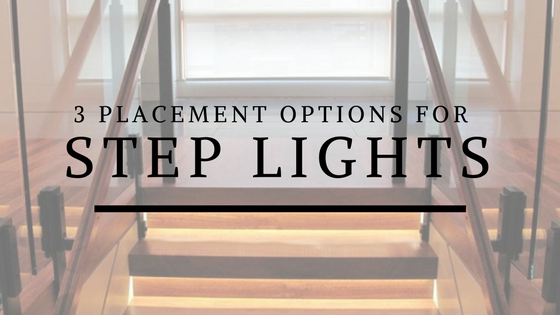There are plenty of reasons to “look down” when planning lighting for your home. Actually, though, most of them fall into the broad categories of safety and beauty. Lighting has come a long way over the centuries and most people no longer view their interior lighting plan as a convenience, but rather as a necessity.
Stairways and interior level changes can be enhanced by modern placement of step lights not only for decorative effect, but also to ensure safety. Although most homes include ceiling or wall-mounted fixtures to light up stairs leading to a second story or to a basement, adequate lighting at foot level is a prime consideration for anyone with vision problems as well as for the mobility impaired. Step lights increase the safety quotient and supply up-to-the-minute convenience as well as dramatic accents.
Floor-level uplighting or “wall-washers” can also add decorative appeal to a stairway, even though they are uncommon.
A Primer for Stair Lights
There are two important decisions to make about stair lights for your new home:
- Where should they be placed?
- What type of lighting is best?
The answers are not difficult, and you have a variety of options. Most homeowners consider step lights as “accessory” illumination in the home; you will almost certainly want some overall illumination in the form of recessed ceiling cans, a chandelier or ceiling-mounted fixture, or a wall sconce or two. Step lights can be purely functional, or they can be used to create dramatic effects.
If you opt for step lights in addition to general lighting, where should you install them?
3 Basic Step Lighting Placement Options
1. In the Step Itself
Individual lights can be installed either horizontally on the tread, or vertically into the riser. It’s not necessary to put a light on each step, but you’ll want to space them in such a way that a general glow is created and no dark spots exist.
If they are installed on the tread, they are most commonly located on one side or the other, sometimes alternating along the course of the stairway. Often, when lights are installed into the riser, they are centered; they can be flush with the riser, but narrow strips or rope lights may also be surface-mounted, usually just under the overhanging edge of the tread.
On open steps, the option exists to install a light on the bottom side of the tread, shining light on the step below. Among the many options are decorative LED lights in many varieties.
In any case, the wiring itself must be installed within the structure of the staircase, and you must select in advance the type of fixture or trim that you want.
2. On the Staircase Wall
Wall sconces are commonly located high enough on the wall so that there is no possibility of “head bumps,” but with enough “light spread” to illuminate the entire distance. Two or three smaller sconces are more pleasing visually than a single large sconce, and fixtures that direct light up towards the ceiling as well as downwards are very effective.
Choosing to mount lighting on the wall is another way to light steps; it can be extremely effective to call attention to a level change from one room to another. Choose the fixture carefully and ensure that it is mounted in a way so that light extends as far as possible toward the center of the step.
Wall mounted lights are also frequently used on interior staircases; they can be decorative as well as functional, and they can also be chosen with the goal of lighting the entire step. Often, it is sufficient to place one light for every three of four steps along the length of the staircase.
3. Bannister or Handrail Lighting
A trendy option for stairway lighting is to embed strip lighting or install decorative rope lighting along the length of a handrail. The strip of light can provide a dramatic focal point in the dark, although it might not provide enough focused light to ensure sure-footed stair climbing.
The Art of Lighting Steps
There are a number of strictly practical considerations — decisions about the size and shape of your lights, about whether they should be battery-operated or hard-wired, even the option to integrate step lights with your smart technology.
Unleash your inner artist by using colored lights, or make dramatic statements with flexible tube lighting, filament lights, exposed bulbs, LED strips or lighted glass steps.
With so many options available for lighting the steps around your home, don’t miss out on the chance to add beauty and to create art as well as to provide safe passage.


